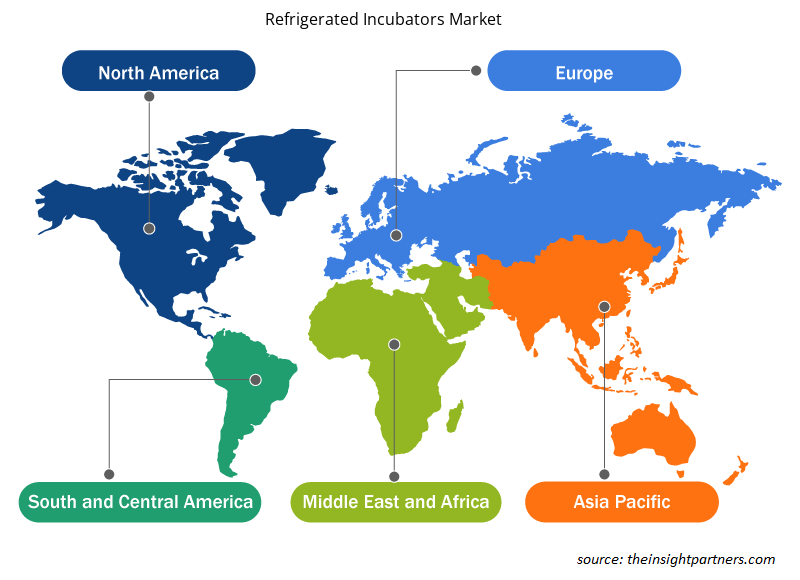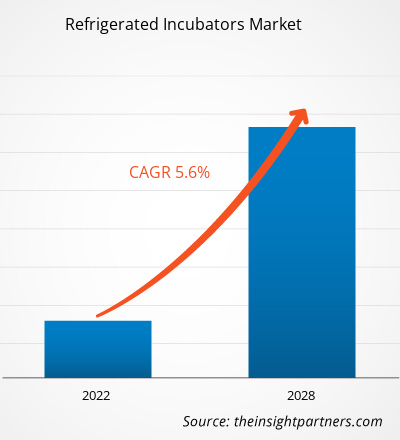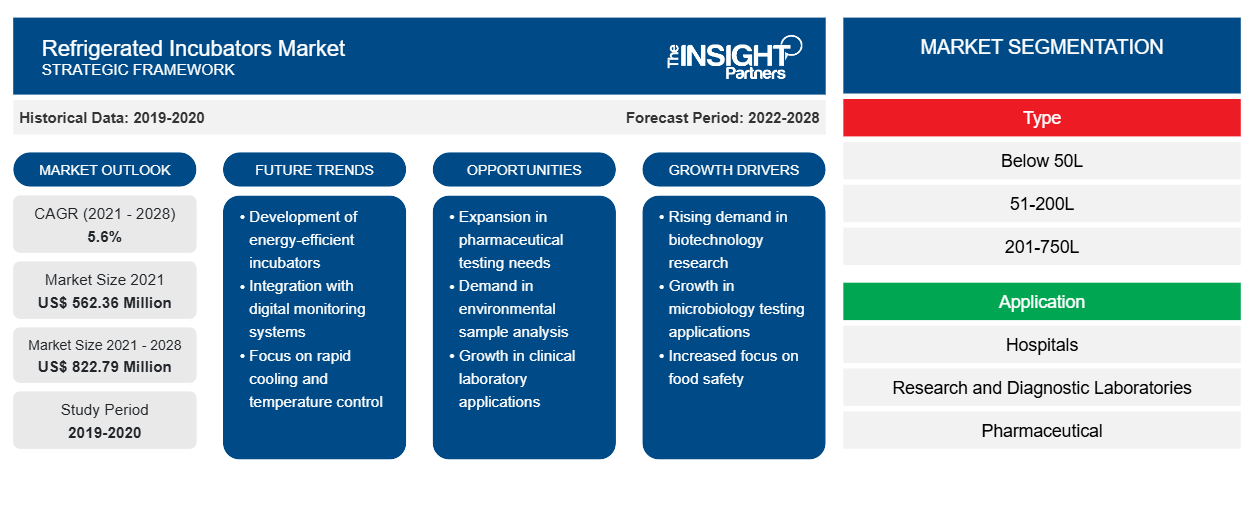Der Markt für Kühlinkubatoren soll von 562,36 Millionen US-Dollar im Jahr 2021 auf 822,79 Millionen US-Dollar im Jahr 2028 anwachsen; von 2021 bis 2028 wird ein durchschnittliches jährliches Wachstum von 5,6 % erwartet.
Die hohe Nutzung von Kühlbrutschränken in Forschungszentren und Laboren treibt das Marktwachstum an. Im medizinischen Sektor spielt die Arbeit mit Mikroorganismen eine entscheidende Rolle. Für die effiziente Produktion und Vermehrung von Mikroorganismen ist eine stabile Inkubationsphase erforderlich. Mit dem technologischen Fortschritt sind Forscher auf Inkubatoren oder Geräte mit modernster Technologie umgestiegen, die im Vergleich zu herkömmlichen Kühlbrutschränken einen geringeren Energieverbrauch haben. Kühlbrutschränke werden beispielsweise in Forschungszentren, pharmazeutischen und biotechnologischen Zentren und Laboren häufig verwendet, da sie den Energieverbrauch senken und eine ungleichmäßige Temperaturverteilung minimieren. Außerdem entwickeln mehrere Top-Wettbewerber, wie die Binder GmbH , Kühlbrutschränke mit einzigartigen Merkmalen, wie beispielsweise einer Kompressionskältemaschine, die einen konstanten Temperaturfluss gewährleistet. Außerdem arbeiten die Kühlbrutschränke mit einer bestimmten konventionellen Technologie, die für eine stabile und konstante Temperatur im Inneren der Brutkammer sorgt.
Angesichts der großen Fortschritte und des Wachstums im Bereich der Biologie durch den Zustrom von Pharmazeutika, Zoologie, Mikrobiologie, Genetik und Ökologie ist der Bedarf an Kühlinkubatoren auf Basis fortschrittlicher Technologie so hoch wie nie zuvor. Top-Wettbewerber wie Being Scientific Inc. bieten Kühlinkubatoren auf Basis fortschrittlicher Technologie an, um das Wachstum und die Lagerung biologischer Proben zu erleichtern. Außerdem ist das Produktangebot des Unternehmens stark auf die Entwicklung von Kühlinkubatoren auf Basis fortschrittlicher Technologie ausgerichtet, die kritische Anwendungen umfassen. Dazu gehört der biologische Sauerstoffbedarf (BSB), der für Abwassertests wirksam ist und in mikrobiologischen, zellbiologischen und pharmazeutischen Laboren gut anwendbar ist und sich für die Lagerung von Medikamenten und biologischen Proben als wirksam erweist. Daher führen steigende F&E-Aktivitäten und Top-Player, die zu innovativen Produkteinführungen im Zusammenhang mit Kühlinkubatoren beitragen, zu einer hohen weltweiten Akzeptanz. Solche Aktivitäten treiben den Umsatz auf dem globalen Markt für Kühlinkubatoren weiter an.
Passen Sie diesen Bericht Ihren Anforderungen an
Sie erhalten kostenlose Anpassungen an jedem Bericht, einschließlich Teilen dieses Berichts oder einer Analyse auf Länderebene, eines Excel-Datenpakets sowie tolle Angebote und Rabatte für Start-ups und Universitäten.
-
Holen Sie sich die wichtigsten Markttrends aus diesem Bericht.Dieses KOSTENLOSE Beispiel umfasst eine Datenanalyse von Markttrends bis hin zu Schätzungen und Prognosen.
Der zunehmende Einsatz von Kühlinkubatoren und die Erhöhung der staatlichen Finanzierung von F&E-Aktivitäten würden dem globalen Markt für Kühlinkubatoren im Prognosezeitraum lukrative Gelegenheiten bieten. Im Bericht der Public Library of Science ( PLOS ) heißt es, dass in den letzten Jahren zahlreiche Herausforderungen im Zusammenhang mit der Bekämpfung neu auftretender Infektionskrankheiten, insbesondere antimikrobieller Resistenzen ( AMR ) und vernachlässigter Krankheiten ( NDs ) aufgetreten sind. So konzentriert sich die Consultative Expert Working Group ( CEWG ) auf die Finanzierung von F&E, und die Koordinierung bei der Weltgesundheitsorganisation (WHO) schlug vor, nach Alternativen zur Finanzierung und Anreizsetzung von F&E sowohl für Innovationen als auch für den Zugang zu neu auftretenden Infektionskrankheiten zu suchen. Zur Information: CEWG und Lancet Commission kündigten globale Gesundheitsfinanzierungen in Höhe von jährlich 6 Milliarden US-Dollar für antimikrobielle Resistenzen ( AMR ) und 10 Milliarden US-Dollar für neu auftretende Infektionen an. Mit der zunehmenden F&E-Aktivitäten zur Bekämpfung neu auftretender Infektionskrankheiten und AMR hat also die Nutzung von Kühlinkubatoren im Laufe der Jahre drastisch zugenommen.
Derzeit investieren Hersteller in Forschungs- und Entwicklungsaktivitäten, um weltweit kostengünstige und hochentwickelte Produkte auf Basis von Kühlinkubatoren einzuführen. Top-Wettbewerber wie Thermo Fischer Scientific haben die Einführung neuer Kühlinkubatoren in regionalen Märkten wie Europa, Asien-Pazifik und Lateinamerika angekündigt. Die Systeme sind in der Pharmazie, den Biowissenschaften, der Wasseraufbereitung, der mikrobiologischen Industrie und bei BOD-Tests weit verbreitet. Die oben genannten Faktoren werden das Wachstum des globalen Marktes für Kühlinkubatoren in den Jahren 2021–2028 fördern.
Nordamerika wird voraussichtlich zwischen 2021 und 2028 den globalen Markt für Kühlinkubatoren dominieren. Die USA halten in dieser Region den größten Marktanteil. Laut dem Bericht von Clinical Trials.gov betreibt die New York Stem Cell Foundation ( NYSCF ) Forschungen zur Erforschung verschiedener Leiden und Erkrankungen, indem sie Stammzellen und andere Zelltypen verwendet, biologische Proben/Proben erforscht, genetische Tests durchführt und diese Proben für kurze Zeit zur späteren Verwendung lagert. Darüber hinaus entwickeln Forscher in US-Laboren Pankreatin- Insulin-produzierende Zellen, um Typ-1-Diabetes, Gehirnzellen und Parkinson zu identifizieren. Solche Faktoren sprechen stark für die Einführung von Kühlinkubatoren in US-Laboren. Darüber hinaus gibt es allein in den USA mehr als 40.000 einzelne Forschungslabore auf Universitätsgeländen, die sich mit der Weiterentwicklung der biologischen und biomedizinischen Wissenschaften befassen. Die Forschung umfasst umfangreiche biologische Proben aus klinischen und Feldstudien, die einen enormen wissenschaftlichen und finanziellen Wert für die Forscher und Organisationen wie Biotech-/ Pharmaunternehmen , Biobanken , Forschungsinstitute und Universitäten darstellen. Die oben genannten Faktoren werden voraussichtlich das Wachstum des globalen Marktes für Kühlinkubatoren im Prognosezeitraum vorantreiben.
Anwendungseinblicke
Basierend auf der Anwendung ist der globale Markt für Kühlinkubatoren in Krankenhäuser, Forschungs- und Diagnoselabore, Pharma-, Kosmetik- und Biotechnologieunternehmen, Forschungs- und akademische Institute und andere unterteilt. Das Segment Krankenhäuser, Forschungs- und Diagnoselabore wird voraussichtlich im Zeitraum 2021–2028 den größten Marktanteil haben. Krankenhäuser spielen eine wichtige Rolle bei der Bereitstellung eines umfassenden Spektrums an medizinischen Dienstleistungen für Patienten mit verschiedenen Krankheiten. Daher ist die zunehmende Nutzung von Kühlinkubatoren in Krankenhäusern aufgrund der steigenden Prävalenz chronischer Infektionen und der besseren Behandlung komplexer Erkrankungen hoch. Darüber hinaus werden solche Inkubatoren in Forschungs- und Diagnoselaboren stark genutzt, da zur Lagerung von Proben unterschiedliche Arten von Kühlinkubatoren erforderlich sind. Die oben genannten Faktoren werden also das globale Marktwachstum für Kühlinkubatoren in diesem Segment im Zeitraum 2021–2028 vorantreiben.
Unternehmen, die auf dem globalen Markt für Kühlinkubatoren tätig sind, verfolgen eine Produktinnovationsstrategie, um den sich weltweit entwickelnden Kundenanforderungen gerecht zu werden und so ihren Markennamen auf dem Weltmarkt zu behaupten.
Regionale Einblicke in den Markt für Kühlinkubatoren
Die regionalen Trends und Faktoren, die den Markt für Kühlinkubatoren im Prognosezeitraum beeinflussen, wurden von den Analysten von Insight Partners ausführlich erläutert. In diesem Abschnitt werden auch die Marktsegmente und die Geografie für Kühlinkubatoren in Nordamerika, Europa, im asiatisch-pazifischen Raum, im Nahen Osten und Afrika sowie in Süd- und Mittelamerika erörtert.

- Erhalten Sie regionale Daten zum Markt für Kühlinkubatoren
Umfang des Marktberichts über Kühlinkubatoren
| Berichtsattribut | Details |
|---|---|
| Marktgröße im Jahr 2021 | 562,36 Millionen US-Dollar |
| Marktgröße bis 2028 | 822,79 Millionen US-Dollar |
| Globale CAGR (2021 - 2028)CAGR (2021 - 2028) | 5,6 % |
| Historische Daten | 2019-2020 |
| Prognosezeitraum | 2022–2028 |
| Abgedeckte Segmente |
Nach Typ
|
| Abgedeckte Regionen und Länder |
Nordamerika
|
| Marktführer und wichtige Unternehmensprofile |
|
Marktteilnehmerdichte für Kühlinkubatoren: Auswirkungen auf die Geschäftsdynamik verstehen
Der Markt für Kühlinkubatoren wächst rasant, angetrieben durch die steigende Endverbrauchernachfrage aufgrund von Faktoren wie sich entwickelnden Verbraucherpräferenzen, technologischen Fortschritten und einem größeren Bewusstsein für die Vorteile des Produkts. Mit steigender Nachfrage erweitern Unternehmen ihr Angebot, entwickeln Innovationen, um die Bedürfnisse der Verbraucher zu erfüllen, und nutzen neue Trends, was das Marktwachstum weiter ankurbelt.
Die Marktteilnehmerdichte bezieht sich auf die Verteilung der Firmen oder Unternehmen, die in einem bestimmten Markt oder einer bestimmten Branche tätig sind. Sie gibt an, wie viele Wettbewerber (Marktteilnehmer) in einem bestimmten Marktraum im Verhältnis zu seiner Größe oder seinem gesamten Marktwert präsent sind.
Die wichtigsten auf dem Markt für Kühlinkubatoren tätigen Unternehmen sind:
- Binder GmbH
- Thermo Fischer Scientific Inc.
- PHC Holding Corporation
- Eppendorf AG
- Amerex Instruments, Inc.
Haftungsausschluss : Die oben aufgeführten Unternehmen sind nicht in einer bestimmten Reihenfolge aufgeführt.

- Erhalten Sie einen Überblick über die wichtigsten Akteure auf dem Markt für Kühlinkubatoren
Globaler Markt für Kühlinkubatoren – Segmentierung
Basierend auf dem Typ ist der globale Markt für Kühlinkubatoren in unter 50 l, 51–200 l, 201–750 l, 751–1500 l und über 1501 l segmentiert. Nach Anwendung ist der Markt in Krankenhäuser, Forschungs- und Diagnoselabore, Pharma-, Kosmetik- und Biotechnologieunternehmen, Forschungs- und akademische Institute und andere segmentiert. Basierend auf der Geografie ist der globale Markt für Kühlinkubatoren hauptsächlich in Nordamerika, Europa, Asien-Pazifik, Naher Osten und Afrika (MEA) sowie Süd- und Mittelamerika segmentiert. Der Markt in Nordamerika ist weiter in die USA, Kanada und Mexiko segmentiert. Der europäische Markt für Kühlinkubatoren ist in Frankreich, Deutschland, Großbritannien, Spanien, Italien und den Rest von Europa unterteilt. Der Markt im Asien-Pazifik-Raum ist in China, Indien, Japan, Australien, Südkorea und den Rest von APAC unterteilt. Der Markt für Kühlinkubatoren im Nahen Osten und Afrika ist weiter segmentiert in Saudi-Arabien, die Vereinigten Arabischen Emirate, Südafrika und den Rest des Nahen Ostens. Der Markt in Süd- und Mittelamerika ist weiter segmentiert in Brasilien, Argentinien und den Rest von Süd- und Mittelamerika.
Firmenprofile
- Binder GmbH
- Thermo Fischer Scientific Inc.
- PHC Holding Corporation
- Eppendorf AG
- Amerex Instruments, Inc.
- Sheldon Manufacturing, Inc.
- LEEC GmbH
- Memmert GmbH+ Co. KG
- Benchmark Wissenschaft
- Gilson Inc.
- Historische Analyse (2 Jahre), Basisjahr, Prognose (7 Jahre) mit CAGR
- PEST- und SWOT-Analyse
- Marktgröße Wert/Volumen – Global, Regional, Land
- Branchen- und Wettbewerbslandschaft
- Excel-Datensatz
Aktuelle Berichte
Erfahrungsberichte
Grund zum Kauf
- Fundierte Entscheidungsfindung
- Marktdynamik verstehen
- Wettbewerbsanalyse
- Kundeneinblicke
- Marktprognosen
- Risikominimierung
- Strategische Planung
- Investitionsbegründung
- Identifizierung neuer Märkte
- Verbesserung von Marketingstrategien
- Steigerung der Betriebseffizienz
- Anpassung an regulatorische Trends























 Kostenlose Probe anfordern für - Markt für gekühlte Inkubatoren
Kostenlose Probe anfordern für - Markt für gekühlte Inkubatoren